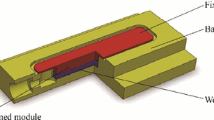Abstract
Material removal and surface generation by erosion is the principle adopted in selected manufacturing processes like abrasive jet machining and abrasive water jet cutting. As the jet velocities involved in these processes are high, they are good for material removal. With low impinging velocities, it is possible to micro erode the surface of the workpiece to achieve good finish. To achieve low velocity impingement, abrasives could be fluidized and the target surface moved against them at the required velocities. This procedure has the limitation that fine abrasive particles are difficult or impossible to fluidize and this need to be addressed to achieve significant improvement in surface finish. For this fine abrasives could be embedded on a larger carrier particle of suitable size that is easy for fluidization. If this carrier is made of elastic material, impact erosion could further be reduced paving way for improved surface finish. In this paper, such abrasive-coated elastomeric spheres of average diameter 3 mm are termed as elastic abrasives. Based on mathematical modelling and experimental investigations, the influence of major process variables and optimal operating conditions has been arrived at. At optimum operating conditions, the surface roughness (Ra value) came down to 0.0267 μm from an initial value of 0.182 μm.
Similar content being viewed by others
References
Komanduri R, Lucca DA, Tani Y (1997) Technological advances in fine abrasive processes. CIRP Ann 46(2):545–597
Jain NK, Jain VK (2001) Modelling of material removal in mechanical type advanced machining processes: a state-of-art review. Int J Mach Tools Manuf 41:1573–1635
Jaganathan R, Radhakrishnan V (1997) A preliminary study on fluidized bed abrasive polishing. Trans NAMRI/SME 25:189–194
Geldart D (2005) The characterization of bulk powders. In: McGlinchey D (ed) Characterization of bulk solids. CRC (Blackwell publishing Ltd), Boca Raton, pp 132–149
Barletta M (2009) Progress in abrasive fluidized bed machining. J Mater Process Technol 209:6087–6102
Massarsky M, Davidson AD (2007) Turbo abrasive machining for edge and surface finishing. Gear Solutions: 23–58
Barletta M, Guarino S, Rubino G, Tagliaferri V (2007) Progress in fluidized bed assisted abrasive jet machining (FB-AJM): internal polishing of aluminium tubes. Int J Mach Tools Manuf 47:483–495
Barletta M, Ceccarelli D, Guarino S, Tagliaferri V (2007) Fluidized bed assisted abrasive jet machining (FB-AJM): precison internal finishing of inconel 718 components. J Manuf Sci Eng (ASME) 129:1045–1059
Barletta M (2006) A new methodology in surface finishing: fluidized bed machining (FBM) of aluminium alloys. J Mater Process Technol 173(2):157–165
Jain VK (2013) Micromanufacturing processes. CRC (Taylor and Francis group), Boca Raton
Singh AK, Jha S, Pandey PM (2012) Nanofinishing of a typical 3D ferromagnetic workpiece using ball end magnetorheological finishing process. Int J Mach Tools Manuf 63:21–31
Mulik RS, Pandey PM (2012) Experimental investigations and modeling of finishing force and torque in ultrasonic assisted magnetic abrasive finishing. J Manuf Sci Eng (ASME) 134:051008
Mohan R, Ramesh Babu N (2010) Experimental investigations on ice bonded abrasive polishing of copper materials. Mater Manuf Process 25:1462–1469
Belyshkin DV (1966) Using ice for polishing glass and crystals. Glas Ceram 23:523–525
Ehrenstein GW (2001) Polymeric materials: structure, properties, applications. Hanser Gardner, Cincinnati
Johnson KL (1985) Contact mechanics. Cambridge University Press, Cambridge
Wu C-Y, Li L-Y (2003) Colin Thornton, rebound behaviour of spheres for plastic impacts. Int J Impact Eng 28:929–946
Levin BF, Vecchio KS, Du Pont JN, Marder AR (1999) Modelling solid-particle erosion of ductile alloys. Metall Mater Trans 30:1763–1774
Sooraj VS, Radhakrishnan V (2013) Elastic impact of abrasives for controlled erosion in fine finishing of surfaces. J Manuf Sci Eng (ASME) 135:051019
Jain VK, Rajani Kumar, Dixit PM, Ajay Sidpara (2009) Investigations into abrasive flow finishing of complex workpiece using FEM. Wear 267:71–80
Montgomory DC (2001) Design and analysis of experiments, 5th edn. Wiley, New York
Wang AC, Lee SJ (2009) Study the characteristics of magnetic finishing with gel abrasive. Int J Mach Tools Manuf 49:1063–1069
Chang G-W, Yan B-H, Hsu R-T (2002) Study on cylindrical magnetic abrasive finishing using unbounded magnetic abrasives. Int J Mach Tools Manuf 42:575–583
Author information
Authors and Affiliations
Corresponding author
Rights and permissions
About this article
Cite this article
Sooraj, V.S., Radhakrishnan, V. A study on fine finishing of hard workpiece surfaces using fluidized elastic abrasives. Int J Adv Manuf Technol 73, 1495–1509 (2014). https://doi.org/10.1007/s00170-014-5889-1
Received:
Accepted:
Published:
Issue Date:
DOI: https://doi.org/10.1007/s00170-014-5889-1




